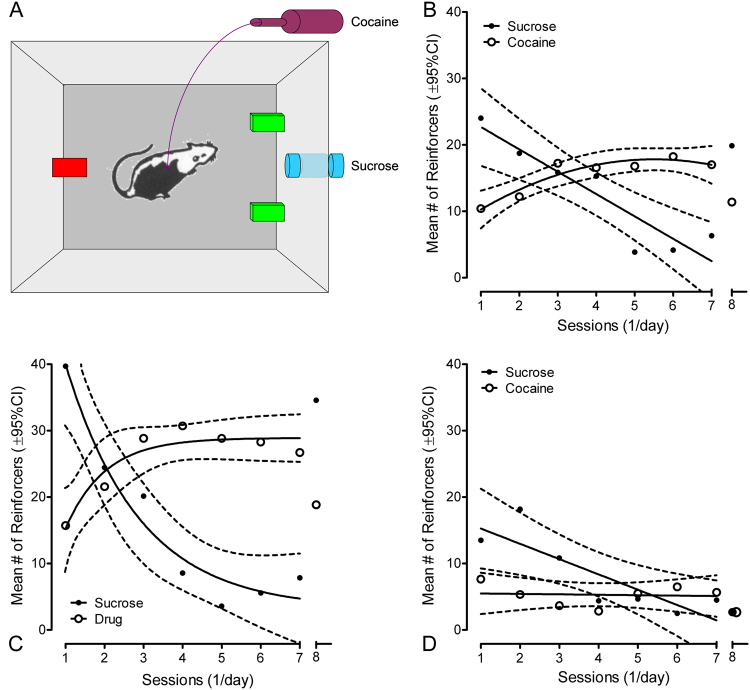Figure 4.
All animals had a history of responding for both sucrose and cocaine, as well as explicit training to preclude the development of a response side bias (diagrammed in A). (B) The choice behavior of the animals across days, collapsed across genotype, displayed a prominent decrease in sucrose reinforcers earned (linear, r2 = 0.85) vs. a prominent increase in cocaine infusions earned (single phase association, r2 = 0.88). The initial choice for sucrose over cocaine by a greater than 2:1 ratio shifted across the 7-day period to a greater than 2:1 ratio for cocaine over sucrose; with the replacement of cocaine with saline on day 8, the drug extinction day, the choice shifted to a return for sucrose over cocaine by an approximate 2:1 ratio. Given the significant genotype × reinforcer type × day interaction [F(4,36) = 3.0, p ≤ 0.05], the choice behavior of the F344 control group and HIV-1 Tg animals is displayed. (C) For the F344 control group, their choice behavior displayed a prominent decrease in sucrose reinforcers earned (single phase decay, r2 = 0.96) vs. a prominent increase in cocaine infusions earned (single phase association, r2 = 0.78). The initial choice for sucrose over cocaine by a greater than 2:1 ratio shifted within 5 days to a greater than 2:1 ratio for cocaine over sucrose. With the replacement of cocaine with saline on day 8, the drug extinction day, the F344 control group displayed a significantly greater number of active lever presses for sucrose on day 8 than they did on day 7, the last day of choice, (t(5) = −2.8, p ≤ 0.05), and had returned to a level that was not significantly different from the number of active lever presses for sucrose on the first day of the choice period. (D) For the HIV-1 Tg group, their choice behavior also displayed a prominent decrease in sucrose reinforcers earned (linear, r2 = 0.72) vs. only a nominal decrease in cocaine infusions earned (linear, r2 = 0.008). The initial choice for sucrose over cocaine by a greater than 2:1 ratio shifted across the 7-day period to no choice preference for cocaine vs. sucrose. No rate change was discernible for cocaine infusions earned across the 7-day period (not significantly different from zero, F(1,5) < 1.0]), despite the fact that the HIV-1 Tg animals nevertheless chose cocaine infusions at a mean level greater than zero [F(1,6) = 74.2, p ≤ 0.001]. With the replacement of cocaine with saline on day 8, the drug extinction day, no differential choice was observed for the sucrose vs. cocaine response levers. Thus, choice behavior was significantly disrupted by the HIV-1 transgene; i.e., although responding of the HIV-1 Tg animals was sensitive to the reinforcing properties of cocaine, it was not driven by any increase in motivated choice behavior for cocaine. (n = 6, HIV-1 transgenic F344/NHsd and n = 7 F344/NHsd controls).

